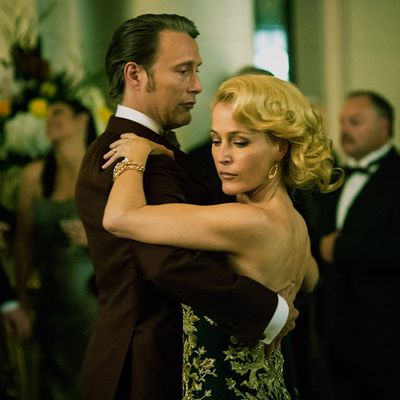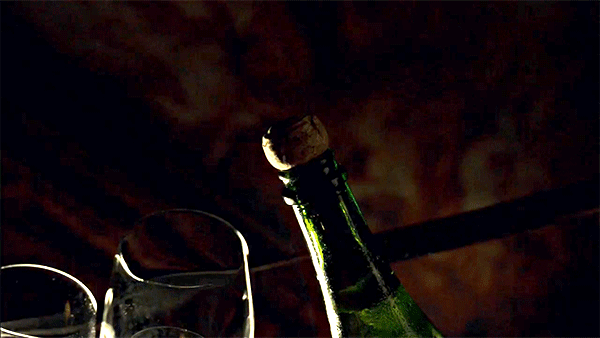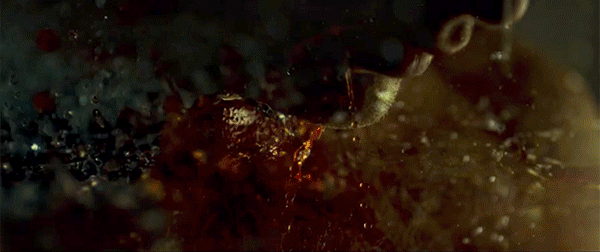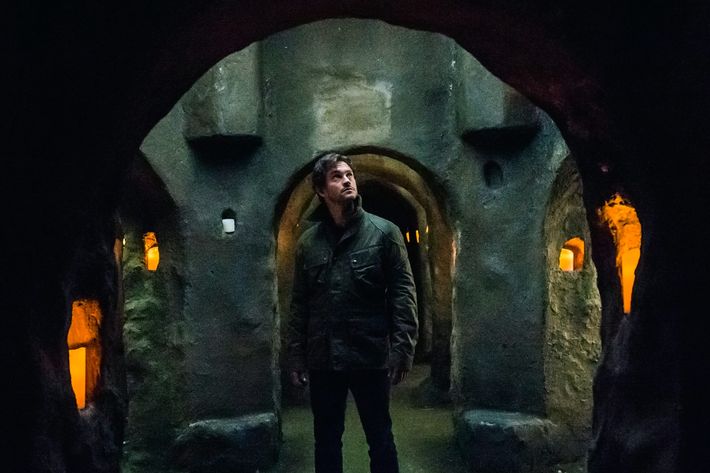
The following post includes light spoilers from the premiere of season three of Hannibal. But we’re mostly talking about the production design, so plot is a trifling concern.
The premiere of the third season of Hannibal finds its namesake living a European fairy tale. Dr. Hannibal Lecter, played by Mads Mikkelsen, motorcycled around Paris before eventually landing in a Florentine apartment with his bride and former analyst, Dr. Bedelia Du Maurier, doing what he does best: dining extravagantly and killing mercilessly. Hannibal has always been an aesthete, and the third season pushes these sensibilities even further: We don’t even see our other protagonist, Will Graham (Hugh Dancy) — never mind the rest of the FBI team — in the first episode, and the procedural structure gives way to flashbacks and abstract images. Last year Matt Zoller Seitz called the show an “emotional procedural”; this year its only form could be called experimental. If the first two seasons had the look of an Impressionist painting, the third one moves deeper into abstraction.
“Going into this season, very much with Bryan’s [Fuller, the showrunner] encouragement, I felt this was a chance to redefine the show and give it a slightly new visual approach while very much keeping it within the continuum of the show,” said Vincenzo Natali, who directed the first three episodes (and the sixth) this season. “It’s like the first season is the childhood, the second season is the adolescence, and the third season is an adult. It’s an autonomous adult — a fully formed creature. It’s just its own thing.”
The show has moved past any of the conventional narrative moors viewers are familiar with on a broadcast show. “I felt that the show was even more romantic and gothic than it had been in the previous two seasons. It had managed to relinquish all the procedural FBI stuff, which, personally, was the one aspect of the show that interested me least,” said Natali. Instead, season three’s early episodes skip between past and present, with the flashbacks shot in a 2.35 aspect ratio and black-and-white. The abstract imagery that Fuller pushed in earlier seasons is in full force in the third. “It’s all very fetishistic,” Natali said about the recurring visual motifs of dripping liquids and rising water.

“There’s an obsessive quality to the visuals on the show and a focus on sensual details.” It’s to look at the world as Hannibal does, where blood and violence become abstracted at the material, tactile level.

Hannibal moves and feels like a Caravaggio painting, or Dalí — steeped in surrealism and painted with big brushstrokes of chiaroscuro. “The lighting is so dark and soft, you don’t even know that it’s lit,” said Natali. “We do a lot of single-point perspective, which is very much in keeping with Renaissance painting.” Natali’s inspirations include Caravaggio as well other Italian Renaissance paintings; Italian horror cinema, like Dario Argento’s Opera; Hélène Cattet; Bruno Forzani’s This Strange Color of Your Body’s Tears; Patricia Highsmith; and a “pinch of Alfred Hitchcock.” He recalled Fuller telling him, “You are making a European art film. Period.”

After the bloodbath that capped off the last season, Hannibal begins anew in Europe, which left the production designers the challenge of mimicking the old beauty of Italy on a soundstage in Toronto. The same obsessive attention to detail was evident in everything from building a facsimile of the Cappella Palatina, a Norman chapel from the 12th century in Palermo, to Hannibal’s Florentine apartment. “We wanted to give it a real rich, lavish feel through materials, millwork, furniture,” said Rory Cheyne, the production designer. “We mainly used a lot of sienna. The color of Florence is so earthy, we just wanted to keep certain gold tones in the beginning.” Both Cheyne and Natali commented on Hannibal’s bathroom, which Natali said was “like a Fabergé egg.” There’s tromp l’oeil detailing and glass that looked like it had something of a painted mirror finish. “It looked so rich, and so Hannibal,” said Cheyne.
Natali found the experience artistically rejuvenating. “That’s just the wonderful situation one finds oneself in when directing Hannibal: You’re not directing TV, which traditionally has not been all that sensitive to the image — but the priorities are starting to change. If you’re directing TV as it’s traditionally thought of, Bryan will throw it out,” said Natali. “The worst sin you can commit is to shoot something that is just de rigueur standard coverage. You’ve got to find the meaning and the poetry in the scene. That’s just the way it’s got to be.”

